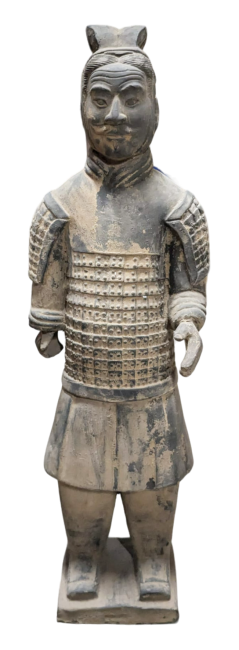Antique Colorful Statue in Terracotta Warrior Mix 16cm x 4 pcs
Quantity: 4 pieces
Approximate size: 16 X 6 X 4 cm
Approximate total weight: 750g
Terracotta figurines are made from fired clay, hand-made, and then carefully finished.
Their appearance is authentically ancient, and each terracotta figurine has subtle differences.
The Terracotta Army, also known as the "Warrior and Horse Figures Buried with the Dead" ( bīngmǎ yǒng), is a collection of nearly eight thousand terracotta sculptures of soldiers and horses, representing the army of Qin Shi Huang, the first emperor of China, intended to protect the emperor on his journey after death, ensuring his safety and power even in the afterlife.
bīngmǎ yǒng), is a collection of nearly eight thousand terracotta sculptures of soldiers and horses, representing the army of Qin Shi Huang, the first emperor of China, intended to protect the emperor on his journey after death, ensuring his safety and power even in the afterlife.
Warrior in Battle Dress: These statues represent one of the categories of soldiers among the Terracotta Army statues. They are usually depicted as soldiers dressed in simple battle dress. Compared to other types of Terracotta Warriors, they often have less equipment and decorations. These soldiers were probably ordinary infantrymen, tasked with guard duties and other general military missions, rather than senior commanders or members of special troops. Their depiction may reflect the typical image of ordinary soldiers in the ancient Chinese army, with simple outfits but unwavering courage and determination.
Knight: These terracotta soldiers are depicted leading horses, tasked with transport and support duties. They are often depicted pulling carts or wagons carrying military supplies. Although their decoration is generally less elaborate, it nevertheless reflects their importance in the logistics of the army. A knight figurine represents a Muslim Hui, an ethnic minority in China, part of the Muslim community.
* Highly replicated terracotta statues of warriors and horses faithfully represent the appearance at the time of their discovery. The aging process is much more complex than that of ordinary statues, requiring meticulous work and a significant period of time. To achieve an authentic appearance, it is necessary to bury them in the ground for a period of time, then dig them up, expose them to the elements, and restore them. Only after this natural erosion process can a realistic effect be achieved. Therefore, their value is considerably high due to the complexity and authenticity of the manufacturing process.




